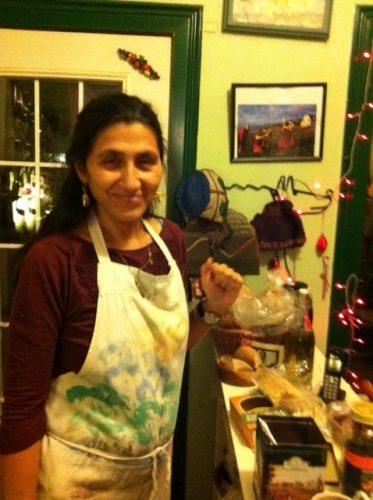We manoeuvred out of a tight parking spot only to have a youth in a black pick- up truck gesture meanly at my driving companion: “Over here we don’t just cut off people like that, Christ! don’t you know how to drive ? ”
I thought it oddly ironic that “over here” was Toronto and that my driving companion not only knew how to drive , but was in fact driving in a city not her own, in a language not her own, actively , bravely acquiring the skills and confidence to practice midwifery in Canada. Originally from Palestine, her training and practice has often been beset by harrowing drives through checkpoints to hospital, staff shortages and supply cuts. Her cut-off had been a very different one from a driving misadventure on a city street of Toronto.
That summer — as we negotiated Toronto’s alley’s and parking lots , gardens, high rises and clogged city lane ways –we sweated away together with each other and together with the exhilarated mothers giving birth to their newborns. My role was in the mentoring of this midwife into Ontario midwifery … and through attending clinical appointments, births, and post partum visits this midwife would pass into the ranks of regulated midwifery.
Midwifery was first regulated as a primary heath care profession in 1994 in Ontario. From that time on, almost all of our provinces and territories also have regulated midwifery. Although Midwifery is found throughout most of the world, in Canada midwives work as primary health professionals. These means they work under their own licenses. Midwives give prenatal appointments, can order blood tests and ultrasounds. Midwives attend births at home, in hospital and at birth centres. Although midwives will consult with doctors and other specialists if necessary, they are to able to conduct and assist a birth on their own. In most provinces midwives will care for mothers and their newborns for six weeks post partum: monitoring baby weights , administering newborn medications and helping with breast feeding. Breast feeding rates of mothers attended by midwives remains very high, supporting the continued advocacy for support of the mother’s post partum in this regard. As members of a self-regulated profession, midwives are governed by their provincial colleges.
Midwifery was born into Canada at the same time as new computer technologies for record keeping, data bases , cell phones and pagers, making this almost twenty-year-old regulated profession uniquely able to take advantage of establishing data bases, evaluative methods, distance learning, client participation , membership discussion and many more innovations. Yet the work and art of midwifery, with its compassion and caring for women undergoing the timeless event of birth, has been retained. Midwives use their heart and hands, care and discussion, time and gentle guidance. As well, midwives maintain their competency in managing emergency situations, and in some provinces also teach ambulance attendants’ skills needed in calls to labouring women. There are some collaborative care models where midwives and family doctors work along side of each other sharing call schedules. Most midwifery care is now funded by provincial levels of government, so the option of midwifery care is available to all. While the numbers of midwives remains small in proportion to the population that request them, this number is steadily growing.
The International Midwifery Pre-Registration program IMPP in Ontario offers a unique one-year program for midwives from other countries seeking registration in Canada. Otherwise, a four year bachelor of health science degree now available at several universities in Canada is the route to midwifery. As a practicing midwife in Toronto, I was able to be involved with several international midwives as they completed their requirements. In doing so, I met a handful of women whose skills and devotion to the business of birth have surpassed displacement , loss of country , and the sometimes strange customs of this, the adoptive land.
Attending birth, standing at the crossroad of new life, is a unique occupation. With the demands of on-call and often night work, juggling of clinical time and home visits, long labours and many meetings, midwifery offers a full, intense, challenging life. Meeting the many students who have come my way, both internationally and through the university programs, has been inspiring. They too want to take up this work. Their willingness to commit and participate on many levels is deeply encouraging. Canadian Midwifery has gained recognition and respect world-wide , through this shared compassion for the work with women and their babies.
I often wonder how I would do if jettisoned into a country and culture so different from my own experience. I am reminded of this every time I gaze at the newborn. She as well is in a new country. Let us listen and be watchful, be kind and be generous for these are our new beginnings.
